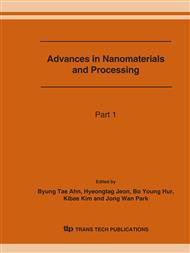[1]
B. O`Regan, M. Grätzel, A low-efficiency solar cell based on dye-sensitized colloidal TiO2 films, Nature 353, 737 (1991)
DOI: 10.1038/353737a0
Google Scholar
[2]
Athapol Kitiyanan, Susumu Yoshikawa, The use of ZrO2 mixed TiO2 nanostructures as efficient dye-sensitized solar cells' electrodes, Materials Letters 59 (2005) 4038 - 4040
DOI: 10.1016/j.matlet.2005.07.080
Google Scholar
[3]
Motonari Adachi, Yusuke Murata, Issei Okada, Susumu Yoshikawa, Formation of titania nanotubes and applications for dye-sensitized solar cells, Journal of The Electrochemical Society, 150 (8) G488-G493 (2003)
DOI: 10.1149/1.1589763
Google Scholar
[4]
Michael Grätzel, Review Dye-sensitized solar cells, Journal of Photochemistry and Photobiology C: Photochemistry Reviews 4 (2003) 145-153
DOI: 10.1016/s1389-5567(03)00026-1
Google Scholar
[5]
G.K. Mor et al.: Fabrication of tapered, conical-shaped titania nanotubes, J. Mater. Res., Vol. 18, No. 11, Nov (2003)
Google Scholar
[6]
Masuda H, Fukuda K. Ordered metal nanohole arrays made by a two-step replication of honeycomb structures of anodic alumina. Science 1995; 268:1466-8. 0.0 0.2 0.4 0.6 0.8 -0.4 -0.3 -0.2 -0.1 0.0 Current density(mA/cm 2) Voltage(V) illumi. 0.00 0.25 0.50 0.75 -1.0 -0.5 0.0 Current density(mA/cm2) Voltage(V) illumi.
DOI: 10.1126/science.268.5216.1466
Google Scholar


